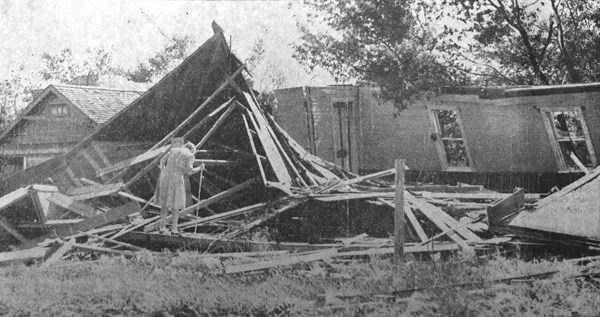This week, in 1944, Kamsack, Sk. was hit by a massive tornado. At that point the worst cyclone in the history of Northeastern Saskatchewan, according to the Yorkton Enterprise, the tornado hit Kamsack from the southeast between nine and ten p.m.
Early estimates, in the August 10, 1944 edition of the Enterprise, printed hours after the cyclone struck, pegged the damage at $1,000,000, but the number doubled to $2,000,000 in the following week’s edition of the paper. All of the grain elevators in Kamsack were destroyed, 291 of the 401 dwellings were described as “almost a total wreck” and 100 businesses were destroyed. The town also lost electricity and telephone.
The three doctors in town at the time, Dr. H.A.L. Portnuff, Dr. M. C. Novak and Dr. R. E. Whitteker all went to Kamsack to assist with the injured, as Kamsack only had one doctor at the time, Dr. J. R. Rehill, who could not cope with the sheer number of wounded in town.
Thirty seven people were injured in the tornado and one, three-year-old Evelyn Diane Padley, was killed.
Four hundred men worked to clear the debris and rebuild the town, including residents from Kamsack and Yorkton, 200 from the army camp at Dundurn and 60 from No. 11 Service Flying Training School Yorkton.
The city banded together to contribute to the Kamsack Emergency Relief Fund, started with a $50,000 contribution from the Province of Saskatchewan. The goal was to raise $500,000, and all local businesses were being canvassed in order to help the Kamsack relief efforts. There were also fundraising events quickly organized, such as the one by the Roxy Theatre, which donated all profits from a screening of “The Man from Down Under” starring Charles Laughton.
It was 1944, so there was still a war going on, but thanks to World War II there was a different crisis at home. Because so many young men were sent overseas, there was not enough labor in the area to harvest the crop. As a result, fifty soldiers from eastern Canada were sent to Yorkton in order to help out. Businesses were also encouraged to allow staff to help out with the farm labor crisis in the area, and transient labor could even get extra ration cards for their efforts.
Speaking of food, Safeway went out of their way to tell people that their apples were not polished. Those apples also happened to be eight cents a pound, while onions were five cents a pound and oranges 11 cents a pound.



